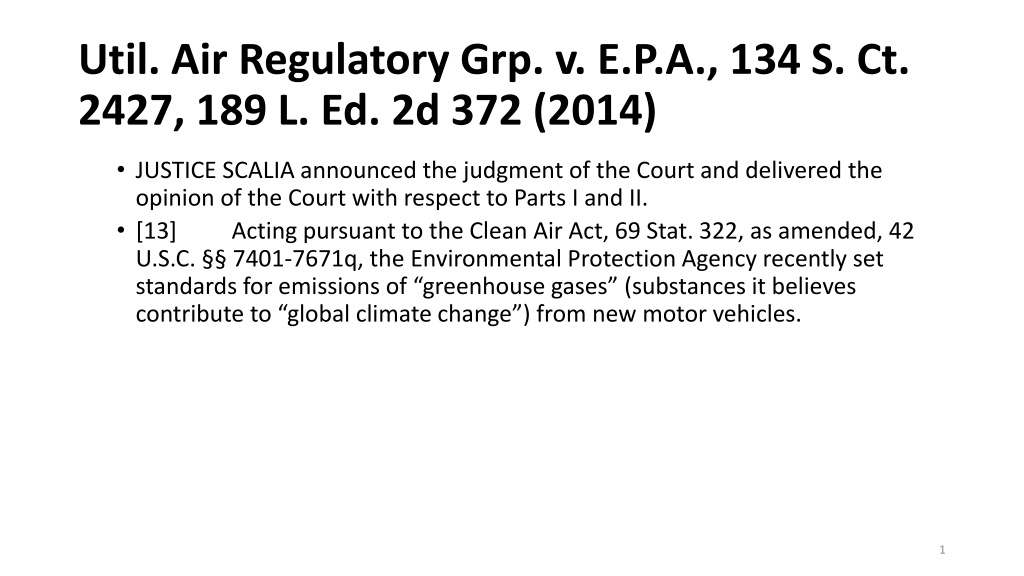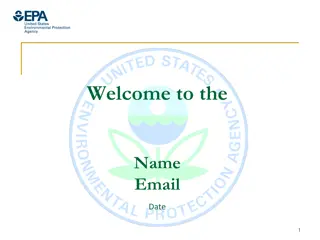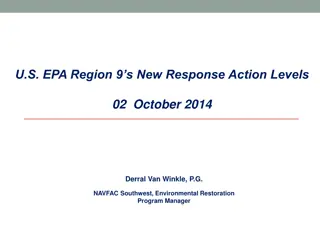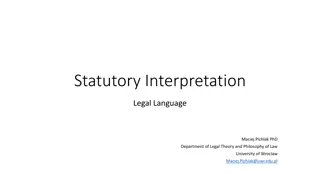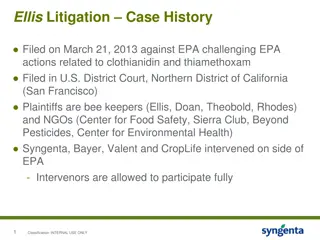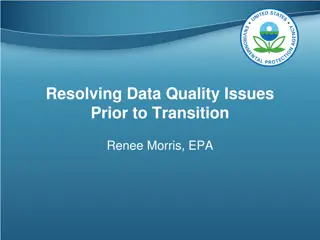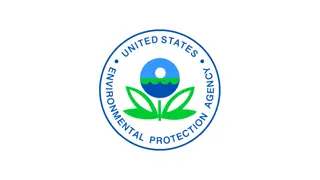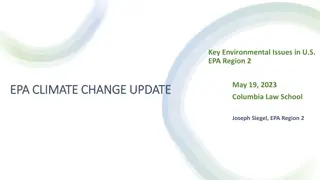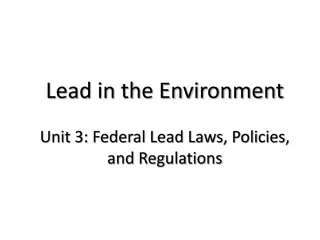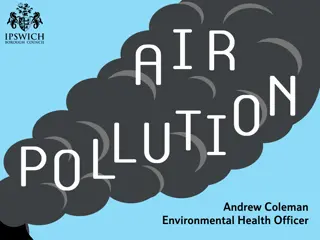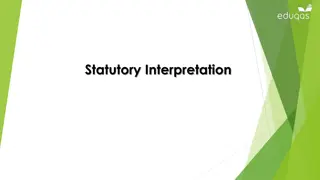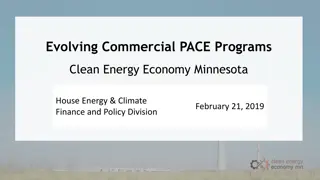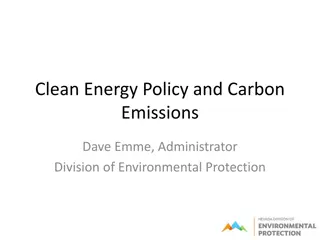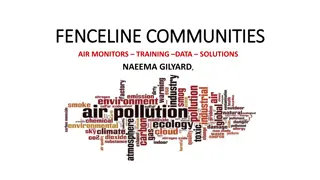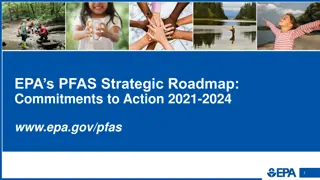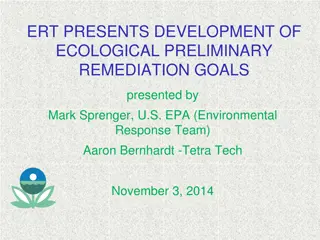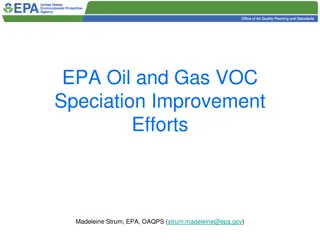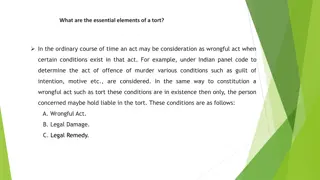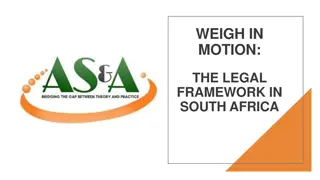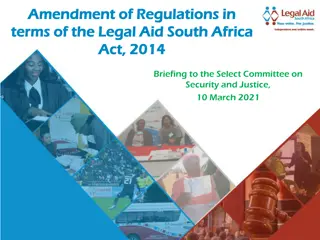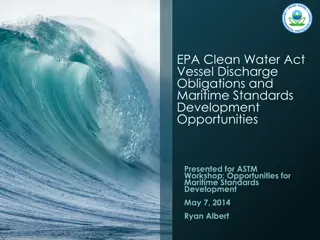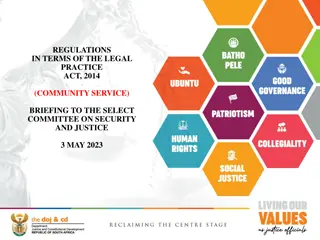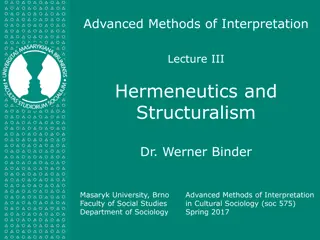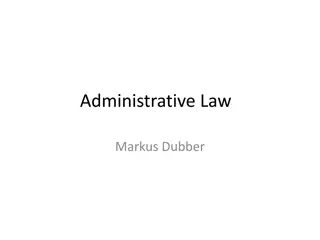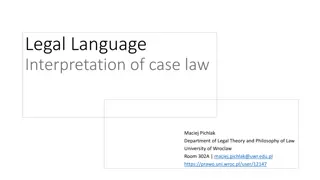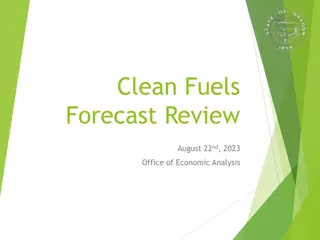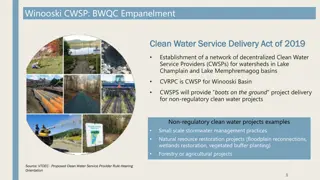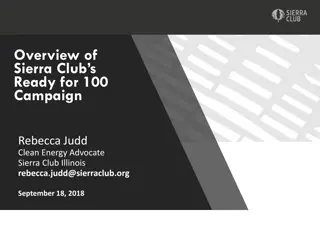EPA Regulations and Clean Air Act: Legal Interpretation
The case of Util. Air Regulatory Grp. v. E.P.A. (2014) addresses whether the EPA's regulations on motor-vehicle greenhouse gas emissions trigger permitting requirements for stationary sources under the Clean Air Act. It delves into the provisions of the Act concerning both stationary and moving sources of pollution, particularly focusing on Titles I and V. The role of the EPA in setting national air quality standards under Title I and the responsibility of states in implementing these standards are explored, highlighting the classification of areas based on NAAQS pollutants. Overall, the case delves into the complex legal implications of EPA regulations on greenhouse gases under the Clean Air Act.
Download Presentation

Please find below an Image/Link to download the presentation.
The content on the website is provided AS IS for your information and personal use only. It may not be sold, licensed, or shared on other websites without obtaining consent from the author. Download presentation by click this link. If you encounter any issues during the download, it is possible that the publisher has removed the file from their server.
E N D
Presentation Transcript
Util. Air Regulatory Grp. v. E.P.A., 134 S. Ct. 2427, 189 L. Ed. 2d 372 (2014) JUSTICE SCALIA announced the judgment of the Court and delivered the opinion of the Court with respect to Parts I and II. [13] Acting pursuant to the Clean Air Act, 69 Stat. 322, as amended, 42 U.S.C. 7401-7671q, the Environmental Protection Agency recently set standards for emissions of greenhouse gases (substances it believes contribute to global climate change ) from new motor vehicles. 1
What is the core question? We must decide whether it was permissible for EPA to determine that its motor-vehicle greenhouse-gas regulations automatically triggered permitting requirements under the Act for stationary sources that emit greenhouse gases. 2
Which provisions of the CAA are at issue? [16] The Clean Air Act regulates pollution-generating emissions from both stationary sources, such as factories and powerplants, and moving sources, such as cars, trucks, and aircraft. This litigation concerns permitting obligations imposed on stationary sources under Titles I and V of the Act. 3
What does Title I set up? [17] Title I charges EPA with formulating national ambient air quality standards (NAAQS) for air pollutants. 7408-7409. 4
What are the NAAQS pollutants? To date, EPA has issued NAAQS for six pollutants: sulfur dioxide, particulate matter, nitrogen dioxide, carbon monoxide, ozone, and lead. Clean Air Act Handbook 125 (J. Domike & A. Zacaroli eds., 3d ed. 2011); see generally 40 CFR pt. 50 (2013). 5
What is the role of the states in Title I? States have primary responsibility for implementing the NAAQS by developing State implementation plans. 42 U.S.C. 7410. A 6
How must the state classify each area in regard to the NAAQS pollutants? State must designate every area within its borders as attainment, nonattainment, or unclassifiable with respect to each NAAQS, 7407(d), and the 7
How does this affect the SIP? State's implementation plan must include permitting programs for stationary sources that vary according to the classification of the area where the source is or is proposed to be located. 7410(a)(2)(C), (I). 8
What are the PSD provisions and where do they apply? [18] Stationary sources in areas designated attainment or unclassifiable are subject to the Act's provisions relating to Prevention of Significant Deterioration (PSD). 7470-7492. EPA interprets the PSD provisions to apply to sources located in areas that are designated attainment or unclassifiable for any NAAQS pollutant, regardless of whether the source emits that specific pollutant. 9
How much of the country is subject to PSD analysis? Since the inception of the PSD program, every area of the country has been designated attainment or unclassifiable for at least one NAAQS pollutant; thus, on EPA's view, all stationary sources are potentially subject to PSD review. 10
What is the significance of being subject to PSD review? [19] It is unlawful to construct or modify a major emitting facility in any area to which [the PSD program] applies without first obtaining a permit. 7475(a)(1), 7479(2)(C). 11
What do you have to show to qualify for a permit? Is this limited to the pollutant that is under control in the region? What is the BACT requirement? To qualify for a permit, the facility must not cause or contribute to the violation of any applicable air-quality standard, 7475(a)(3), and it must comply with emissions limitations that reflect the best available control technology (or BACT) for each pollutant subject to regulation under the Act. 7475(a)(4). [What is BACT for GHGs at this time? Now? Remember, there is a CBA test on the impact on the industry.] 12
What is a major emitting facility? The Act defines a major emitting facility as any stationary source with the potential to emit 250 tons per year of any air pollutant (or 100 tons per year for certain types of sources). 7479(1). 13
What is a modification? Does this always involve physical changes in the plant? It defines modification as a physical or operational change that causes the facility to emit more of any air pollutant. 7411(a)(4). *fn1 14
What does Title V require of major sources? [20] In addition to the PSD permitting requirements for construction and modification, Title V of the Act makes it unlawful to operate any major source, wherever located, without a comprehensive operating permit. 7661a(a). 15
Does Title V impose specific pollution control requirements? Unlike the PSD program, Title V generally does not impose any substantive pollution-control requirements. 16
What is its regulatory value? Instead, it is designed to facilitate compliance and enforcement by consolidating into a single document all of a facility's obligations under the Act.The permit must include all emissions limitations and standards that apply to the source, as well as associated inspection, monitoring, and reporting requirements. 7661c(a)-(c). Title V defines a major source by reference to the Act-wide definition of major stationary source, which in turn means any stationary source with the potential to emit 100 tons per year of any air pollutant. 7661(2)(B), 7602(j). [21] [22] In 2007, the Court held that Title II of the Act authorize[d] EPA to regulate greenhouse gas emissions from new motor vehicles if the Agency form[ed] a 'judgment' that such emissions contribute to climate change. Massachusetts v. EPA, 549 U.S. 497, 528, 127 S. Ct. 1438, 167 L. Ed. 2d 248 (quoting 7521(a)(1)). In response to that decision, EPA embarked on a course of regulation resulting in the single largest expansion in the scope of the [Act] in its history. Clean Air Act Handbook, at xxi. [23] EPA first asked the public, in a notice of proposed rulemaking, to comment on how the Agency should respond to Massachusetts. In doing so, it explained that regulating greenhouse-gas emissions from motor vehicles could have far-reaching consequences for stationary sources. 17
What did EPA say would happen if it adopted tailpipe regulations for GHGs? Under EPA's view, once greenhouse gases became regulated under any part of the Act, the PSD and Title V permitting requirements would apply to all stationary sources with the potential to emit greenhouse gases in excess of the statutory thresholds: 100 tons per year under Title V, and 100 or 250 tons per year under the PSD program depending on the type of source. 73 Fed. Reg. 44420, 44498, 44511 (2008). 18
What is the small source problem? Because greenhouse-gas emissions tend to be orders of magnitude greater than emissions of conventional pollutants, EPA projected that numerous small sources not previously regulated under the Act would be swept into the PSD program and Title V, including smaller industrial sources, large office and residential buildings, hotels, large retail establishments, and similar facilities. Id., at 44498- 44499. 19
Did EPA think this expansion would have regulatory value? The Agency warned that this would constitute an unprecedented expansion of EPA authority that would have a profound effect on virtually every sector of the economy and touch every household in the land, yet still be relatively ineffective at reducing greenhouse gas concentrations. Id., at 44355. *fn2 Remember, this EPA is defending excluding these sources. 20
Did EPA find that GHGs were a threat to public health? [24] In 2009, EPA announced its determination regarding the danger posed by motor-vehicle greenhouse-gas emissions. EPA found that greenhouse- gas emissions from new motor vehicles contribute to elevated atmospheric concentrations of greenhouse gases, which endanger public health and welfare by fostering global climate change. 74 Fed. Reg. 66523, 66537 (hereinafter Endangerment Finding). It denominated a single air pollutant the combined mix of six greenhouse gases that it identified as the root cause of human-induced climate change : carbon dioxide, methane, nitrous oxide, hydrofluorocarbons, perfluorocarbons, and sulfur hexafluoride. Id., at 66526, 66537. A source's greenhouse-gas emissions would be measured in carbon dioxide equivalent units (CO2e), which would be calculated based on each gas's global warming potential. Id., at 66499, n. 4. 21
What did EPA say in the Triggering Rule? [25] Next, EPA issued its final decision regarding the prospect that motor-vehicle greenhouse-gas standards would trigger stationary-source permitting requirements. 75 Fed. Reg. 17004 (2010) (hereinafter Triggering Rule). EPA announced that beginning on the effective date of its greenhouse- gas standards for motor vehicles, stationary sources would be subject to the PSD program and Title V on the basis of their potential to emit greenhouse gases. As expected, EPA in short order promulgated greenhouse-gas emission standards for passenger cars, light-duty trucks, and medium-duty passenger vehicles to take effect on January 2, 2011. 75 Fed. Reg. 25324 (hereinafter Tailpipe Rule). 22
Why didnt EPA just exclude GHGs from the Title I program and avoid the tailoring issue entirely? [26] EPA then announced steps it was taking to tailor the PSD program and Title V to greenhouse gases. 75 Fed. Reg. 31514 (hereinafter Tailoring Rule). Those steps were necessary, it said, because the PSD program and Title V were designed to regulate a relatively small number of large industrial sources, and requiring permits for all sources with greenhouse- gas emissions above the statutory thresholds would radically expand those programs, making them both unadministrable and unrecognizable to the Congress that designed them. Id., at 31555, 31562. EPA nonetheless rejected calls to exclude greenhouse gases entirely from those programs, asserting that the Act is not ambiguous with respect to the need to cover [greenhouse-gas] sources under either the PSD or title V program. Id., at 31548, n. 31. Instead, EPA adopted a phase-in approach that it said would appl[y] PSD and title V at threshold levels that are as close to the statutory levels as possible, and do so as quickly as possible, at least to a certain point. Id., at 31523. 23
Was EPA only going to regulate major emitters, or would the regulations eventually be expanded to small sources? 24
What is BACT for GHGs? [27] The phase-in, EPA said, would consist of at least three steps. During Step 1, from January 2 through June 30, 2011, no source would become newly subject to the PSD program or Title V solely on the basis of its greenhouse-gas emissions; however, sources required to obtain permits anyway because of their emission of conventional pollutants (so-called anyway sources) would need to comply with BACT for greenhouse gases if they emitted those gases in significant amounts, defined as at least 75,000 tons per year CO2e. Ibid. During Step 2, from July 1, 2011, through June 30, 2012, sources with the potential to emit at least 100,000 tons per year CO2e of greenhouse gases would be subject to PSD and Title V permitting for their construction and operation and to PSD permitting for modifications that would increase their greenhouse- gas emissions by at least 75,000 tons per year CO2e. Id., at 31523-31524. *fn3 At Step 3, beginning on July 1, 2013, EPA said it might (or might not) further reduce the permitting thresholds (though not below 50,000 tons per year CO2e), and it might (or might not) establish permanent exemptions for some sources. Id., at 31524. Beyond Step 3, EPA promised to complete another round of rulemaking by April 30, 2016, in which it would take further action to address small sources, which might (or might not) include establishing permanent exemptions. Id., at 31525. 25
Who contested the rule? [28] EPA codified Steps 1 and 2 at 40 CFR 51.166(b)(48) and 52.21(b)(49) for PSD and at 70.2 and 71.2 for Title V, and it codified its commitments regarding Step 3 and beyond at 52.22, 70.12, and 71.13. See Tailoring Rule 31606-31608. After the decision below, EPA issued its final Step 3 rule, in which it decided not to lower the thresholds it had established at Step 2 until at least 2016. 77 Fed. Reg. 41051 (2012). [30] Numerous parties, including several States, filed petitions for review in the D. C. Circuit under 42 U.S.C. 7607(b), challenging EPA's greenhouse- gas-related actions. The Court of Appeals dismissed some of the petitions for lack of jurisdiction and denied the remainder. Coalition for Responsible Regulation, Inc. v. EPA, 684 F. 3d 102, 401 U.S. App. D.C. 306 (2012) (per curiam). 26
What did the lower court hold? First, it upheld the Endangerment Finding and Tailpipe Rule. Id., at 119, 126. Next, it held that EPA's interpretation of the PSD permitting requirement as applying to any regulated air pollutant, including greenhouse gases, was compelled by the statute. Id., at 133-134. The court also found it crystal clear that PSD permittees must install BACT for greenhouse gases. Id., at 137. Because it deemed petitioners' arguments about the PSD program insufficiently applicable to Title V, it held they had forfeited any challenges to EPA's greenhouse gas-inclusive interpretation of Title V. Id., at 136. Finally, it held that petitioners were without Article III standing to challenge EPA's efforts to limit the reach of the PSD program and Title V through the Triggering and Tailoring Rules. Id., at 146. The court denied rehearing en banc, with Judges Brown and Kavanaugh each dissenting. No. 09-1322 etc. (Dec. 20, 2012), App. 139, , 2012 WL 6621785. 27
What is the only question before this court? [31] We granted six petitions for certiorari but agreed to decide only one question: 'Whether EPA permissibly determined that its regulation of greenhouse gas emissions from new motor vehicles triggered permitting requirements under the Clean Air Act for stationary sources that emit greenhouse gases.' 571 U.S. ____, 134 S. Ct. 418, 187 L. Ed. 2d 278 (2013). [32] [33] This litigation presents two distinct challenges to EPA's stance on greenhouse-gas permitting for stationary sources. 28
What are the two challenges to the reg? First, we must decide whether EPA permissibly determined that a source may be subject to the PSD and Title V permitting requirements on the sole basis of the source's potential to emit greenhouse gases. 29
What is an anyway source? Second, we must decide whether EPA permissibly determined that a source already subject to the PSD program because of its emission of conventional pollutants (an anyway source) may be required to limit its greenhouse-gas emissions by employing the best available control technology for greenhouse gases. 30
What is the significance of the anyway source category? The Solicitor General joins issue on both points but evidently regards the second as more important; he informs us that anyway sources account for roughly 83% of American stationary-source greenhouse- gas emissions, compared to just 3% for the additional, non- anyway sources EPA sought to regulate at Steps 2 and 3 of the Tailoring Rule. Tr. of Oral Arg. 52. 31
What is the standard for reviewing EPAs interpretation of the CAA? [34] We review EPA's interpretations of the Clean Air Act using the standard set forth in Chevron U.S. A. Inc. v. Natural Resources Defense Council, Inc., 467 U.S. 837, 842-843, 104 S. Ct. 2778, 81 L. Ed. 2d 694 (1984). Under Chevron, we presume that when an agency-administered statute is ambiguous with respect to what it prescribes, Congress has empowered the agency to resolve the ambiguity. The question for a reviewing court is whether in doing so the agency has acted reasonably and thus has stayed within the bounds of its statutory authority. This may be the last big Chevron case. 34
Chevron Step 1 [36] We first decide whether EPA permissibly interpreted the statute to provide that a source may be required to obtain a PSD or Title V permit on the sole basis of its potential greenhouse-gas emissions. [EPA interpretation] [38] EPA thought its conclusion that a source's greenhouse-gas emissions may necessitate a PSD or Title V permit followed from the Act's unambiguous language. The Court of Appeals agreed and held that the statute compelled EPA's interpretation. 684 F. 3d, at 134. We disagree. The statute compelled EPA's greenhouse-gas-inclusive interpretation with respect to neither the PSD program nor Title V. *fn4 35
[39] The Court of Appeals reasoned by way of a flawed syllogism: Under Massachusetts, the general, Act-wide definition of air pollutant includes greenhouse gases; the Act requires permits for major emitters of any air pollutant ; therefore, the Act requires permits for major emitters of greenhouse gases. 36
Where does the court say this falls apart? In Massachusetts, the Court held that the Act-wide definition includes greenhouse gases because it is all-encompassing; it embraces all airborne compounds of whatever stripe. 549 U.S., at 529, 127 S. Ct. 1438, 167 L. Ed. 2d 248. But where the term air pollutant appears in the Act's operative provisions, EPA has routinely given it a narrower, context-appropriate meaning. 37
How has EPA limited Title V in the past? [41] That is certainly true of the provisions that require PSD and Title V permitting for major emitters of any air pollutant. Since 1978, EPA's regulations have interpreted air pollutant in the PSD permitting trigger as limited to regulated air pollutants, And since 1993 EPA has informally taken the same position with regard to the Title V permitting trigger, a position the Agency ultimately incorporated into some of the regulations at issue here. Those interpretations were appropriate: It is plain as day that the Act does not envision an elaborate, burdensome permitting process for major emitters of steam, oxygen, or other harmless airborne substances. It takes some cheek for EPA to insist that it cannot possibly give air pollutant a reasonable, context-appropriate meaning in the PSD and Title V contexts when it has been doing precisely that for decades. 38
Are there Other Examples? [42] Nor are those the only places in the Act where EPA has inferred from statutory context that a generic reference to air pollutants does not encompass every substance falling within the Act-wide definition. Other examples abound: [43] Although these limitations are nowhere to be found in the Act- wide definition, in each instance EPA has concluded-as it has in the PSD and Title V context-that the statute is not using air pollutant in Massachusetts' broad sense to mean any airborne substance whatsoever. 39
Does Mass v. EPA Eliminate this Discretion? [44] Massachusetts did not invalidate all these longstanding constructions. That case did not hold that EPA must always regulate greenhouse gases as an air pollutant everywhere that term appears in the statute, but only that EPA must ground its reasons for action or inaction in the statute, rather than on reasoning divorced from the statutory text . EPA's inaction with regard to Title II was not sufficiently grounded in the statute, the Court said, in part because nothing in the Act suggested that regulating greenhouse gases under that Title would conflict with the statutory design. Title II would not compel EPA to regulate in any way that would be extreme, counterintuitive, or contrary to 'common sense.' At most, it would require EPA to take the modest step of adding greenhouse-gas standards to the roster of new-motor-vehicle emission regulations. Ibid. 40
Does Mass v. EPA require the regulation of GHGs? [45] Massachusetts does not strip EPA of authority to exclude greenhouse gases from the class of regulable air pollutants under other parts of the Act where their inclusion would be inconsistent with the statutory scheme. The Act-wide definition to which the Court gave a sweeping and capacious interpretation is not a command to regulate, but a description of the universe of substances EPA may consider regulating under the Act's operative provisions. Massachusetts does not foreclose the Agency's use of statutory context to infer that certain of the Act's provisions use air pollutant to denote not every conceivable airborne substance, but only those that may sensibly be encompassed within the particular regulatory program. 41
Does Mass require that GHG be pollutants for all purposes? As certain amici felicitously put it, while Massachusetts rejected EPA's categorical contention that greenhouse gases could not be 'air pollutants' for any purposes of the Act, it did not embrace EPA's current, equally categorical position that greenhouse gases must be air pollutants for all purposes regardless of the statutory context. Brief for Administrative Law Professors et al. as Amici Curiae 17. *fn5 42
Is the Act Ambiguous? [46] To be sure, Congress's profligate use of air pollutant where what is meant is obviously narrower than the Act-wide definition is not conducive to clarity. One ordinarily assumes 'that identical words used in different parts of the same act are intended to have the same meaning.' Environmental Defense v. Duke Energy Corp., 549 U.S. 561, 574, 127 S. Ct. 1423, 167 L. Ed. 2d 295 (2007). In this respect (as in countless others), the Act is far from a chef d'oeuvre of legislative draftsmanship. But we, and EPA, must do our best, bearing in mind the 'fundamental canon of statutory construction that the words of a statute must be read in their context and with a view to their place in the overall statutory scheme.' FDA v. Brown & Williamson Tobacco Corp., 529 U.S. 120, 133, 120 S. Ct. 1291, 146 L. Ed. 2d 121 (2000). 43
Do the words always mean just what that say alone? As we reiterated the same day we decided Massachusetts, the presumption of consistent usage 'readily yields' to context, and a statutory term-even one defined in the statute- may take on distinct characters from association with distinct statutory objects calling for different implementation strategies. Duke Energy, supra, at 574, 127 S. Ct. 1423, 167 L. Ed. 2d 295. 44
Does the court find that the EPA is required to trigger PSD and Title V? [47] We need not, and do not, pass on the validity of all the limiting constructions EPA has given the term air pollutant throughout the Act. We merely observe that taken together, they belie EPA's rigid insistence that when interpreting the PSD and Title V permitting requirements it is bound by the Act- wide definition's inclusion of greenhouse gases, no matter how incompatible that inclusion is with those programs' regulatory structure. [48] In sum, there is no insuperable textual barrier to EPA's interpreting any air pollutant in the permitting triggers of PSD and Title V to encompass only pollutants emitted in quantities that enable them to be sensibly regulated at the statutory thresholds, and to exclude those atypical pollutants that, like greenhouse gases, are emitted in such vast quantities that their inclusion would radically transform those programs and render them unworkable as written. *fn6 [49] 45
Is the Interpretation Within the EPAs Discretion? [50] Having determined that EPA was mistaken in thinking the Act compelled a greenhouse-gas-inclusive interpretation of the PSD and Title V triggers, we next consider the Agency's alternative position that its interpretation was justified as an exercise of its discretion to adopt a reasonable construction of the statute. Tailoring Rule 31517. We conclude that EPA's interpretation is not permissible. 46
The Reasonability Standard [51] Even under Chevron's deferential framework, agencies must operate within the bounds of reasonable interpretation. And reasonable statutory interpretation must account for both the specific context in which . . . language is used and the broader context of the statute as a whole. A statutory provision that may seem ambiguous in isolation is often clarified by the remainder of the statutory scheme . . . because only one of the permissible meanings produces a substantive effect that is compatible with the rest of the law. Thus, an agency interpretation that is inconsisten[t] with the design and structure of the statute as a whole, does not merit deference. [Brown and Williamson] 47
What is Applying PSD to GHGs Reasonable? [52] EPA itself has repeatedly acknowledged that applying the PSD and Title V permitting requirements to greenhouse gases would be inconsistent with-in fact, would overthrow-the Act's structure and design. In the Tailoring Rule, EPA described the calamitous consequences of interpreting the Act in that way. Under the PSD program, annual permit applications would jump from about 800 to nearly 82,000; annual administrative costs would swell from $12 million to over $1.5 billion; and decade-long delays in issuing permits would become common, causing construction projects to grind to a halt nationwide. Tailoring Rule 31557. The picture under Title V was equally bleak: The number of sources required to have permits would jump from fewer than 15,000 to about 6.1 million; annual administrative costs would balloon from $62 million to $21 billion; and collectively the newly covered sources would face permitting costs of $147 billion. Id., at 31562-31563. Moreover, the great majority of additional sources brought into the PSD and title V programs would be small sources that Congress did not expect would need to undergo permitting. Id., at 31533. EPA stated that these results would be so contrary to congressional intent, and would so severely undermine what Congress sought to accomplish, that they necessitated as much as a 1,000-fold increase in the permitting thresholds set forth in the statute. Id., at 31554, 31562. 48
Based on Brown and Williamson, what does the court think is implied when an interpretation leads to unreasonable results? [53] Like EPA, we think it beyond reasonable debate that requiring permits for sources based solely on their emission of greenhouse gases at the 100- and 250-tons-per-year levels set forth in the statute would be incompatible with the substance of Congress' regulatory scheme. Brown & Williamson, 529 U.S., at 156, 120 S. Ct. 1291, 146 L. Ed. 2d 121. A brief review of the relevant statutory provisions leaves no doubt that the PSD program and Title V are designed to apply to, and cannot rationally be extended beyond, a relative handful of large sources capable of shouldering heavy substantive and procedural burdens. 49
How does the structure of the PSD program belie its expansion to a huge number of small emitters? [54] Start with the PSD program, which imposes numerous and costly requirements on those sources that are required to apply for permits. Among other things, the applicant must make available a detailed scientific analysis of the source's potential pollution-related impacts, demonstrate that the source will not contribute to the violation of any applicable pollution standard, and identify and use the best available control technology for each regulated pollutant it emits. 7475(a)(3), (4), (6), (e). The permitting authority (the State, usually) also bears its share of the burden: It must grant or deny a permit within a year, during which time it must hold a public hearing on the application. 7475(a)(2), (c). Not surprisingly, EPA acknowledges that PSD review is a complicated, resource- intensive, time-consuming, and sometimes contentious process suitable for hundreds of larger sources, not tens of thousands of smaller sources. 74 Fed. Reg. 55304, 55321-55322. 50
